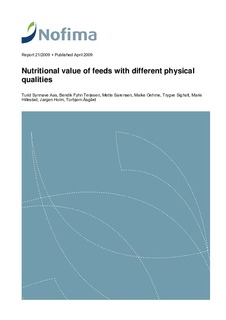| dc.description.abstract | In a previously performed study, rainbow trout with mean initial weight 1144 g was fed two experimental feeds with similar chemical composition, but differing in physical properties (high and low water stability, denoted Feed A and B, respectively). The fish was also exposed to stable or fluctuating environment (salinity, temperature and O2 saturation). The feed intake was highest in trout fed Feed B, and when kept at stable environment. The growth tended to follow the same pattern (not significantly though). At termination of the trial, the stomachs of trout fed Feed B contained the largest amounts of feed material. The stomachs of these fish also contained large amounts of free water and oil, most severely in trout kept at stable environment, coinciding with the highest feed intake. In the present experiment, the physical properties of the two feeds were further investigated. Feed A had less dust, more unbroken pellets, higher hardness, larger diameter and shorter pellets than Feed B. The apparent digestibility (ADC, %) of protein (the sum of amino acids) and most individual amino acids, starch, dry matter, energy and phosphorus was highest in Feed A. The environmental treatment also affected the ADC of some amino acids and minerals. In general however, the ADC appeared to be reduced at high feed intake. The plasma concentrations of sodium and chloride ions were not affected by the feed, but were elevated in individuals kept at the constant environment. The results clearly demonstrate that the nutritional value of a feed is affected by its physical properties. Furthermore, several of the treatment effects in the fish caused by physical feed properties, may be related to the feed intake. | |
